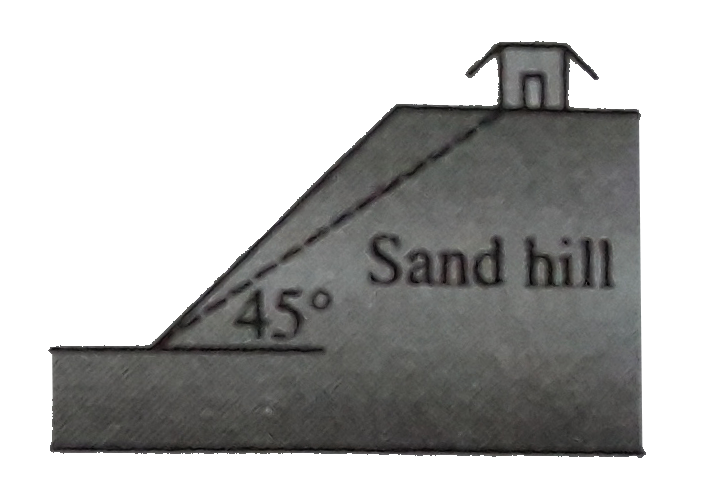If you want to pile up sand onto a circular area of radius R. The greatest height of the sand pile that can be created without spilling the sand onto the surrounding. Area, if μ is the coefficient of friction between sand particle is:
μ2R
μR
R
Rμ
The correct Answer is:b
Topper's Solved these Questions
- BOOK - ANURAG MISHRACHAPTER - FORCE ANALYSISEXERCISE - Level-273videos
FORCE ANALYSIS
- BOOK - ANURAG MISHRACHAPTER - FORCE ANALYSISEXERCISE - Level-349videos
FORCE ANALYSIS
- BOOK - ANURAG MISHRACHAPTER - FORCE ANALYSISEXERCISE - Example95videos
FORCE ANALYSIS
- BOOK - ANURAG MISHRACHAPTER - DESCRIPTION OF MOTIONEXERCISE - Level-334videos
DESCRIPTION OF MOTION
- BOOK - ANURAG MISHRACHAPTER - IMPULSE AND MOMENTUMEXERCISE - matching3videos
IMPULSE AND MOMENTUM
Similar Questions
A worker wishes to pile a cone of sand onto a circular area in his yard. The radius of the circle is r,and no sand is to spill on to the surrounding area. If μ is the static coefficient of friction between each layer of sand along the slope and the sand, show that the greatest volume of sand that can be stored in this manner is 13πμR3.
View SolutionA worker wishes to pile up sand on to a circular area of radius R. No sand is to spill on to the surrounding area. If μs is the coefficient of static friction of sand on sand,the sand pile . Density of sand =ρ
View Solution
Knowledge Check
- Question 1 - Select One
The greatest height h of the sand pile that can be erected without spilling the sand onto the surrounding circular area of radius R (If μ is the coefficient of friction between sand particles) is
ARBRμCμRDμ2R - Question 2 - Select One or More
A worker wishes to pile up sand on to a circular area of radius R. No sand is to spill on to the surrounding area. If μs is the coefficient of static friction sand particles, then choose the correct statement (s)
AThe greatest height of sand pile that can be created is μsR.BThe greatest height of sand pile that can be created is R/μsCMinimum work required to create greatest height sand pile is π12μ2sR4ρg. Where ρ is the density of sand volumeDSand pile will be in stable equilibrium - Question 3 - Select One
The maximum speed that can be achieved without skidding by a car on a circular unbanked road of radius R and coefficient of static friction μ , is
AμRgBRg√μCμ√RgD√μRg
A copper rod of mass m rests on two horizontal rails distance L apart and carries a current of I from one rail to the other. The coefficient of static friction between rod and rails is μs What are the (a) magnitude and (b) angle (relative to the vertical) of the smallest magnetic field that puts the rod on the verge of sliding?
View SolutionA car is moving along a banked road laid out as a circle of radius r . (a) What should be the banking angle θ so that the car travelling at speed v needs no frictional force from tyres to negotiate the turn ? (b) The coefficient of friction between tyres and road are μs=0.9 and μk=0.8 . At what maximum speed can a car enter the curve without sliding toward the top edge of the banked turn ?
 View Solution
View SolutionA car is moving along a banked road laid out as a circle of radius r . (a) What should be the banking angle θ so that the car travelling at speed v needs no frictional force from tyres to negotiate the turn ? (b) The coefficient of friction between tyres and road are μs=0.9 and μk=0.8 . At what maximum speed can a car enter the curve without sliding toward the top edge of the banked turn ?
 View Solution
View SolutionA flat race track consists of two straight section AC and DB each of length 180 m and one semi circular section DC of radius R = 150 m. A car starting from rest at A has to reach B in least possible time (the car may cross through point B and need not stop there). The coefficient of friction between the tyres and the road is μ=0.6 and the top speed that the car can acquire is 180 kph. Find the minimum time needed to move from A to B under ideal conditions. Braking is not allowed in the entire journey [g=10m/s2]
 View Solution
View SolutionA house is built on the top of a hill with 45∘slope Due to the sliding of meterial and sand top from top to the bottom of till , the slip angle has been redaced if the coefficient of static friction between sand particles is 0.75 what is the final angle attated by bill ? (tan−10.75=37∘)
 View Solution
View Solution

